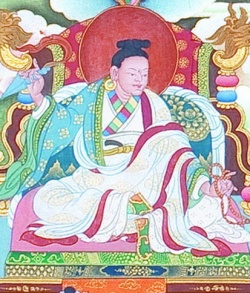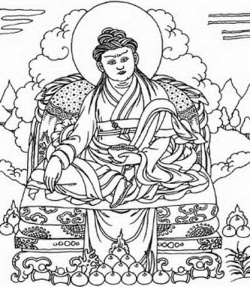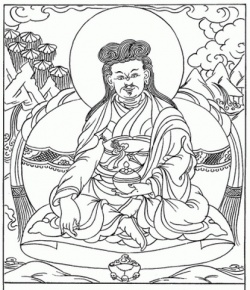Difference between revisions of "Tradition of “Treasure Revelation” in Tibet"
m (URL fix) |
m (1 revision) |
(No difference)
| |
Revision as of 17:27, 17 May 2013
A review of Delivering the Lotus-born: Historiography in the Tibetan Renaissance, by Daniel Alexander Hirshberg.
This dissertation focuses on the life and works of the first and foremost “king of treasure-revealers,” Nyang ral Nyi ma ’od zer (1124–1192, henceforth Nyang ral). The revelation of religious and historiographical texts as “treasure” (gter) has become an important tradition influencing all major schools of Buddhism in Tibet. Treasure revealers and their defenders today claim that the texts and objects were buried (either in the ground or in the mind of the future revealer) during the eighth century, when Buddhism first flourished in Tibet. They believe most treasure to have been interred by the Indian master and “second Buddha,” Padmasambhava.
Many other Tibetans over the centuries, and most Tibetologists over the last hundred years, have questioned the claimed antiquity of these treasures, but those on both sides of the argument generally agree on the typology of the treasures and the ostensive process by which they are revealed. Hirshberg here seeks to problematize this shared ground, and thus move the debate beyond the dichotomy of miracle versus forgery of a reified thing called treasure (gter ma). This he attempts through an analysis of biographies on Nyang ral. These biographies suggest that the earliest treasure revelations did not conform to either the later typology of treasures, or the traditional depiction of the process of treasure discovery.
Hirshberg (following Michel Foucault) argues that the shared rubric of what constitutes treasure in Tibet is in danger of “obscuring the diachronic process by which the treasures became a tradition” (p. 3). However, he does not seek to simply deconstruct the tradition of treasure revelation, but rather to question its expressed generalities from a Buddhist perspective of conventional truth, “where all generalities are empty and negated by analysis, but when applied critically… remain useful as rhetorical conveniences” (p. 4). The dissertation follows the pattern of a traditional Tibetan life story: pre-incarnations (Chapter 1); early life (Chapter 2); famed activities (Chapter 3); the content of his oeuvre (Chapter 4) and the work of his later disciples (as Hirshberg conceives of the historiographical works attributed to Nyang ral in Chapter 5 and the conclusion).
The introduction contains a detailed discussion of Nyang ral’s dates, updating Gyurme Dorje and Matthew Kapstein’s assessments by bringing new evidence to bear on the question (pp. 12-19). Chapter 1 then argues that Nyang ral saw his life as the seventeenth in a line of “concatenated reincarnation” (p. 21), beginning with the Tibetan emperor (btsan po) Khri Srong lde brtsan (742-c.800), a contemporary of Padmasambhava. This self-identification helped justify Nyang ral’s claim to have discovered the texts and magically charged objects that Padmasambhava bestowed on the emperor, and then buried as treasure around Tibet: “Nyang-rel was among the first Tibetans who attested to an unbroken sequence of lifetimes in support of that claim” (pp. 22-23). Hirshberg discusses the precedents of this identification, citing Paul Harrison, Matthew Kapstein and Anne-Marie Blondeau (pp. 23-26). He then explicates the justificatory narrative of these reincarnations (pp. 26-37), ascribing them to one of Nyang ral’s spiritual descendants, Guru Chos dbang (1212-1270) (p. 53). Hirshberg argues that the latter adapted this narrative to make himself the final and preeminent reincarnation of Khri Srong lde brtsan (pp. 55-67) — thus eclipsing Nyang ral in later Buddhist tradition (pp. 67-76).
Chapter 2 (pp. 77-100) unpacks the karmic and tantric symbolism surrounding the early life of Nyang ral, according to his biographies. An earlier version of this chapter was published as a journal article, to which this reviewer would like to direct interested readers (Daniel Hirshberg, “Karmic Foreshadowing on the Path of Fruition: Narrative Devices in the Biographies of Nyang ral Nyi ma ’od zer,” Bulletin of Tibetology 45.1 [2010], pp. 53-78).
Chapter 3 begins by reviewing the secondary literature on treasure discovery, contrasting the work of Michael Aris with that of Janet Gyatso, Matthew Kapstein and Ronald Davidson (pp. 103-111). This preliminary discussion highlights an over-simplified reification of the process of treasure discovery and the dichotomy of the in/authentic debate about the true provenance of treasure texts. Hirshberg seeks to avoid these pitfalls in the rest of the chapter. He instead interrogates the undated biographical depictions of Nyang ral’s career as a treasure-revealer (gter ston) in order to gain a phenomenological sense of their shared and divergent perspectives on the process (p. 112), rather than perpetuating a monolithic representation such as that given by Bdud ’joms Rin po che (p. 122). Through this analysis, Hirshberg uncovers the difference between the biographies’ descriptions of treasure revelation and those of the later tradition, the latter exemplified by Sprul sku Don grub Rin po che (p. 127 n 44). This difference mostly consists of the earlier absence of elements later taken as standard tropes of the treasure tradition, for instance text written in unintelligible “ḍākinī script” (pp. 129-133), or the active agency of the revealer in drawing out the treasure from hiding (pp. 152-156).
This analysis of the biographies continues into Chapter 4, where Hirshberg emphasizes the lack of any mention of exalted-mind or pure-vision treasure —in other words treasures discovered in the adept’s mind and not in physical form (pp. 165-172). He makes the important point that “all of the treasures described in Nyang-rel’s primary biographies are actual material objects” (p. 168). In this respect, Hirshberg agrees with Dan Martin’s and Ronald Davidson’s assessments of early Bon (non-Buddhist) treasure. He then describes the objects and texts that formed the content of Nyang ral’s treasure discoveries according to his biographies, relying in part on David Germano and relating the treasures to their traditional emic systematization of later times (pp. 173-197). In the process, Hirshberg largely eschews Janet Gyatso’s description of legitimacy (p. 194) in favour of a karmic explanatory framework, in which Nyang ral’s discoveries are due to his preincarnation as Khri Srong lde brtsan. These then set up the karmic conditions for his revelation of new treasure caches (pp. 178-180). Building on the work of Cathy Cantwell and Robert Mayer, Hirshberg argues that some of these texts may have been real “finds,” such as an archaeologist might discover, but that any “old texts recovered from secret or protected caches were treasures to Nyang-rel” (p. 195). He then tempers this statement in support of the genuine antiquity of some treasure texts, by going on to maintain “the suspicion that at least some of his treasures were authored by his own hand” (p. 196).
Such is the case with the Copper Palace (Zangs gling ma), the earliest full-length hagiography of Padmasambhava. Tradition identifies Copper Palace as a treasure text discovered by Nyang ral, but Hirshberg maintains in Chapter 5 that there is “compelling evidence that Nyang-rel was the source of the text” (p. 205). The rest of the chapter is taken up with a detailed analysis of this text and another religious history (chos ’byung) that is attributed to Nyang ral’s hand, the Flower Nectar (Me tog snying po). After describing the introphon and early parts of Flower Nectar (pp. 211-216), Hirshberg draws on the 2011 University of London thesis by Lewis Doney (the present reviewer) to describe the earliest attested recension of Copper Palace and its inclusion, augmented with other narratives, into Flower Nectar (pp. 216-27). He then thoroughly investigates an apparent addendum to the history (pp. 233-236) and the various codas and colophons that end Flower Nectar (pp. 236-250). Hirshberg expresses his doubts over the twelfth-century antiquity of these sections, and argues instead that “it is unlikely that Nyang-rel contributed any of the material after [the section retelling] the Copper Palace [narrative]” (p. 207). This in turn throws doubt on the authenticity of the introphon (p. 251), and even the wholesale attribution of Flower Nectar to Nyang ral (pp. 251-52). Hirshberg speculates that his disciples “attributed Flower Nectar to Nyang-rel so that the history would acquire the prestige of their master, which was eventually successful” (p. 251).
In the conclusion, Hirshberg offers some speculative “alternative hypotheses” (p. 262) to the received wisdom that ascribes treasure status to Copper Palace (p. 253), or Nyang ral’s authorship to Flower Nectar (pp. 256-260). He concludes by arguing that both works may have been compiled by others (pp. 260-262). This is a case of “devil’s advocacy,” by which he wishes to “identify and destabilize certain theses as untested assumptions” (p. 262). Hirshberg intends this problematization to inspire further study, “such that by knowing less we in fact learn more” about these narratives and Nyang ral (p. 265).
The published work arising from this dissertation will prove valuable not only as an introduction to the biographical tradition on Nyang ral, but also as a necessary complication of the simplistic description sometimes given for this “king of treasure-revealers.” First, Hirshberg shows that a deeper understanding of the earliest Buddhist practices of treasure revelation in Tibet could help in overcoming the doubts that Western practitioners commonly encounter when presented with claims for the antiquity and concomitant authenticity of treasure texts. Maps and photographs given throughout also help to orient the more general reader (and the specialist!) to the power places where Nyang ral’s life story and treasure discoveries are said to have taken place.
Second, in describing Nyang ral’s life and discoveries, Hirshberg approaches his two biographies as texts, rather than accepting them as scripture representing in toto the faithfully transcribed words of their subject. This offers both Western Buddhists and scholars not only one of the first but more importantly a critical introduction to the biographies on Nyang ral. This comparison of the conflicting reports is of great value as a support when looking into Nyang ral’s life story.
Finally, this description of texts unsettles comfortable academics from their established routine of ascribing authorship to historical sources by relying on the august Tibetan and/or Tibetological traditions of its attribution. Hirshberg implies that every work should be interrogated first as a compilation of unknown date (see also his brief discussion of the works of ’Ju Mi pham [1846–1912], pp. 211-212). Only if a text passes this test can it be then considered as in some sense an author’s work and thus representative of his or her beliefs or what he or she wanted others to believe. Thus, while the dissertation maintains an emic perspective throughout, it situates its point of view from within the critical tradition of Western Tibetan Buddhism. It thereby admirably counters the homogenization of both the traditional explanation of treasure discovery and also the biographical tradition on Nyang ral.
Lewis J. A. Doney PhD
“Kingship and Religion in Tibet” Research Group
Institute for Indology and Tibetology
LMU, Munich
lewis.doney@lrz.uni-muenchen.de
Primary Sources
Biographies containing the life story of Nyang ral Nyi ma ’od zer:
Dri ma med pa by Chos kyi ’od zer, Myang ston bsod nams seng ge, and Mi ’gyur rdo rje
Three sources for Gsal ba’i me long by Myang ston Rig ’dzin Lhun grub ’od zer
Skabs brgyad ma by Gu ru Chos kyi dbang phyug
Historiographical works attributed to Nyang ral:
Four sources for Flower Nectar (Me tog snying po)
Two sources for Copper Palace (Zangs gling ma)
Dissertation Information
Harvard University. 2012. 291pp. Primary Advisor: Leonard W. J. van der Kuijp.


